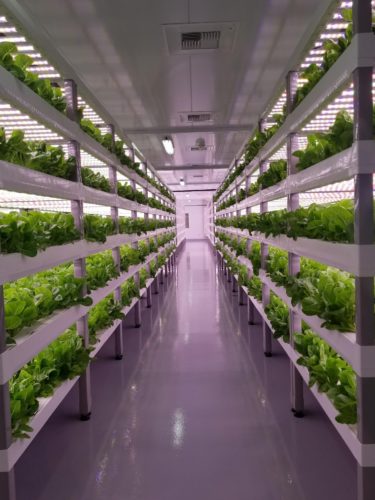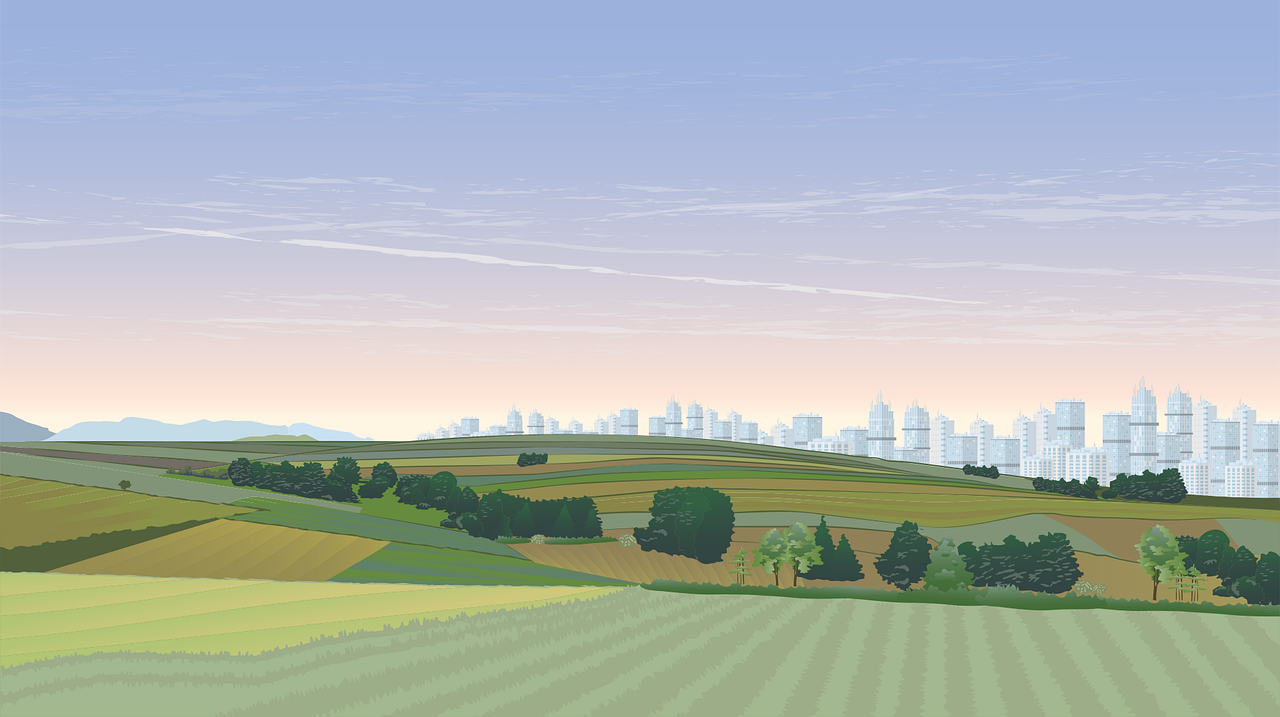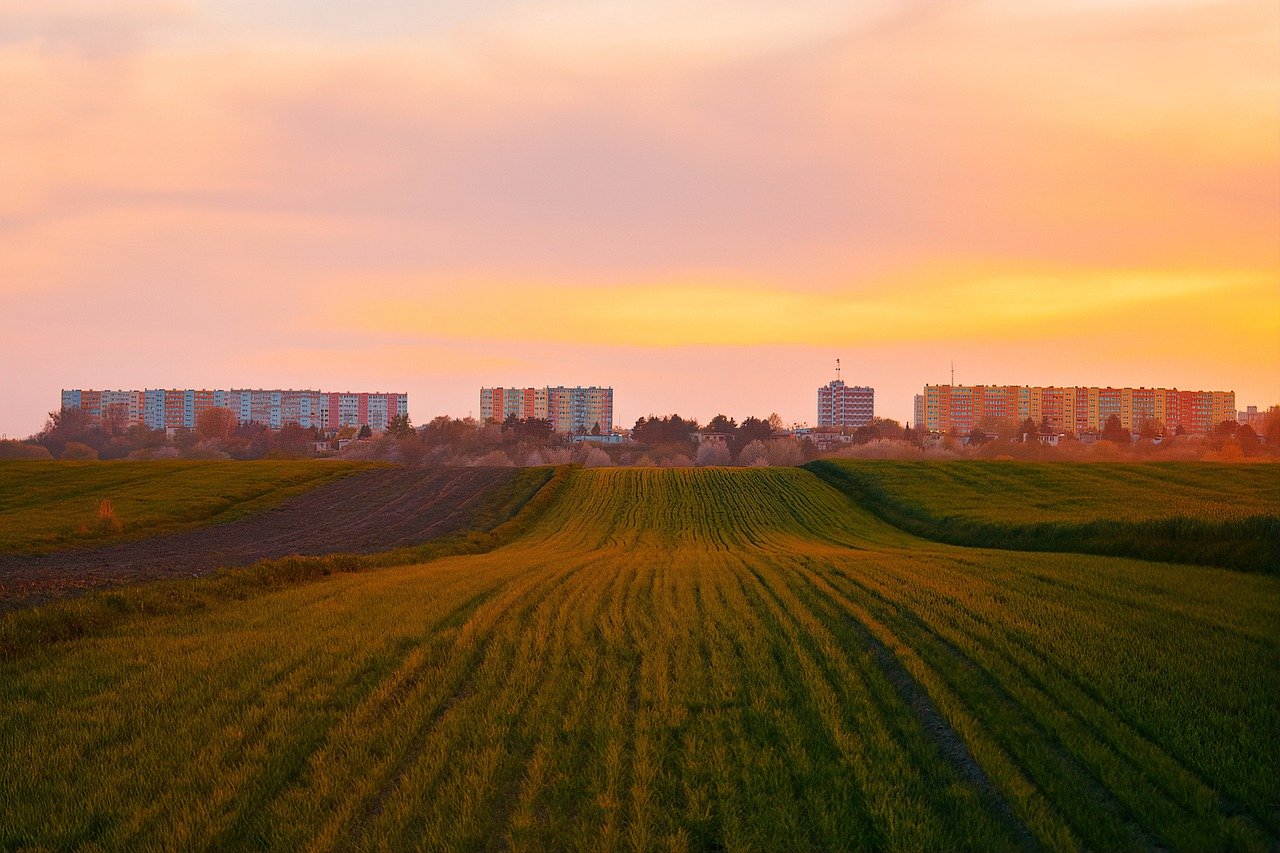Introduction
Urbanization is on the rise, with more than half of the world’s population living in cities. As urban areas expand, the demand for fresh, locally sourced food is growing. Traditional agriculture faces challenges in meeting this demand due to limited space, transportation costs, and environmental concerns. In response, vertical farming has emerged as a transformative solution, revolutionizing urban agriculture.
The global trend toward urbanization is undeniable, as over half of the world’s population now resides in cities. This mass migration to urban areas is driven by various factors, including economic opportunities and improved quality of life. However, as cities continue to expand, they face an increasingly pressing challenge: ensuring a steady supply of fresh, locally sourced food for their growing populations.
Traditional agriculture, with its vast fields and sprawling farmlands, struggles to meet the demands of urban areas for several reasons:
Limited Space: Urban environments are characterized by limited available land for agriculture. The competition for land often drives up its cost, making large-scale traditional farming impractical within city limits.
Transportation Costs: Transporting produce from rural areas to cities incurs significant expenses, including fuel, labor, and infrastructure maintenance. These costs are passed on to consumers, contributing to higher food prices.
Environmental Concerns: Conventional farming practices can have adverse environmental impacts, such as soil degradation, water pollution, and greenhouse gas emissions. These issues are particularly concerning in densely populated urban regions.
In response to these challenges, vertical farming has emerged as a revolutionary solution that holds immense promise for urban agriculture.
Vertical farming leverages innovative technologies to cultivate crops in stacked layers or vertically inclined surfaces, such as skyscrapers, shipping containers, or repurposed industrial spaces. This approach offers several transformative benefits:
Space Efficiency: Vertical farms maximize land use by growing crops upward rather than outward. This allows for high crop yields in a fraction of the space required by traditional agriculture. Vertical farms can thrive in urban environments, taking advantage of available vertical space.
Local Production: By locating vertical farms within or near urban centers, food production becomes hyper-local. This significantly shortens the distance between farm and table, reducing transportation costs, carbon emissions, and the environmental footprint associated with food distribution.
Resource Efficiency: Vertical farms utilize controlled environments, where factors like light, temperature, and humidity are optimized for crop growth. This precision farming minimizes water usage, reduces pesticide needs, and enables year-round cultivation, enhancing resource efficiency.
Freshness and Quality: The proximity of vertical farms to consumers ensures that produce reaches markets and restaurants at peak freshness. This not only improves taste and nutritional value but also reduces food waste.
Year-Round Production: Vertical farms can operate year-round, unaffected by seasonality or adverse weather conditions. This consistent supply of fresh produce helps meet urbanites’ year-round demand for fruits and vegetables.
Sustainability: Vertical farming can be designed with sustainability in mind, utilizing renewable energy sources, implementing recycling systems, and reducing reliance on harmful agricultural practices.
As urbanization continues its upward trajectory, vertical farming is positioned to play a pivotal role in ensuring urban food security, reducing the environmental impact of agriculture, and promoting sustainable living. This transformative approach represents a critical step toward reimagining the future of urban agriculture, where fresh, healthy, and locally sourced food is readily available to city dwellers, contributing to healthier urban communities and a more sustainable world.
Explore this link for a more extensive examination of the topic: Vertical Farming in Greenhouses: Revolutionizing Yield and …
Vertical farming is an innovative approach to agriculture that involves cultivating crops in vertically stacked layers or vertically inclined surfaces. This method contrasts with traditional horizontal farming, where crops are grown in open fields or greenhouses. Vertical farms utilize controlled environment agriculture (CEA) techniques such as hydroponics, aeroponics, and aquaponics to optimize growing conditions.
Vertical farming represents a paradigm shift in agriculture, challenging the conventions of traditional farming methods. Let’s delve deeper into the innovative aspects of this approach and how controlled environment agriculture (CEA) techniques are at its core:
1. Space Utilization Beyond Limits: Vertical farming harnesses the full potential of available space. Unlike horizontal farming, which is constrained by land availability, vertical farms can extend skyward. This means that in densely populated urban areas or regions with limited arable land, vertical farming offers a lifeline to agricultural self-sufficiency.
2. Climate Control Precision: One of the defining features of vertical farming is its ability to control the growing environment with precision. CEA techniques allow farmers to manipulate factors like temperature, humidity, light, and even carbon dioxide levels. This level of control ensures optimal conditions for crop growth year-round, free from the unpredictability of external climates.
3. Water Efficiency Through Hydroponics: Hydroponics is a cornerstone of vertical farming. It involves growing plants without soil, instead suspending their roots in nutrient-rich water. This technique not only conserves water by recycling it within the system but also eliminates the need for soil-borne pests, reducing reliance on chemical pesticides.
4. Airborne Growth with Aeroponics: Aeroponics takes water efficiency to the next level. In this method, plants are suspended in air, and a nutrient-rich mist is delivered directly to their roots. This allows for maximum nutrient absorption and rapid growth while minimizing water usage. Aeroponics is especially valuable in arid regions where water conservation is paramount.
5. Aquaponics: A Harmony of Fish and Plants: Aquaponics combines aquaculture (fish farming) and hydroponics. Fish waste provides nutrients for plant growth, while the plants filter and purify the water for the fish. This symbiotic relationship results in a closed-loop system that maximizes resource utilization and reduces waste.
6. Year-Round Crop Availability: Traditional farming is often limited to seasonal harvests. Vertical farming transcends these limitations by enabling continuous year-round production. This reliability is crucial for urban areas and regions with harsh climates where fresh produce may be scarce during certain times of the year.
7. Precise Crop Selection: Vertical farms can select crops based on factors like growth rate and demand. This flexibility allows for tailored cultivation to meet market demands efficiently. Additionally, it opens doors to experimentation with non-traditional crops, expanding the diversity of locally grown foods.
8. Sustainability and Food Security: Vertical farming addresses some of the most pressing challenges of our time—sustainability and food security. By using resources efficiently, reducing waste, and minimizing environmental impact, vertical farms promote responsible food production practices that are essential for future generations.
As urbanization continues to accelerate, vertical farming’s ability to provide fresh, locally sourced food becomes increasingly critical. With its innovative use of space, precise control over growing conditions, and efficient resource utilization, vertical farming stands as a beacon of hope for sustainable, resilient, and urban-centric agriculture.
Explore this link for a more extensive examination of the topic: The Rise of Vertical Farming: Revolutionizing Agriculture | by …

Vertical farming maximizes space utilization. Crops are stacked in multiple layers, allowing for high plant density. This means that vertical farms can produce more food per square foot than traditional farms.
Vertical farming stands at the forefront of agricultural innovation, reimagining how we utilize space and cultivate crops. The core principle of this method is ingenious: stacking crops in multiple layers to achieve an unparalleled plant density. This revolutionary approach translates to a remarkable increase in food production per square foot, challenging the limitations of traditional farming.
At its essence, vertical farming harnesses the three-dimensional potential of space. Instead of spreading crops across expansive fields, it capitalizes on the vertical dimension, effectively multiplying the available growing area. This shift is particularly crucial in urban environments, where arable land is limited and valuable.
One of the standout features of vertical farming is its ability to operate year-round, irrespective of weather conditions. By creating a controlled environment indoors, vertical farms are not beholden to the seasons. This means that fresh, locally grown produce can be available consistently, reducing the need for long-distance transportation and cold storage.
Furthermore, the precision and automation inherent in vertical farming provide an ideal environment for optimizing plant growth. Factors such as temperature, humidity, and light can be fine-tuned to perfection. This level of control minimizes resource waste, as crops receive exactly what they need, when they need it. Additionally, it reduces the reliance on chemical inputs, enhancing sustainability.
The reduced environmental impact of vertical farming extends to water usage as well. Advanced irrigation systems, including hydroponics and aeroponics, allow for efficient water recycling and minimal wastage. In a world grappling with water scarcity, this conservation is invaluable.
Vertical farming’s ability to produce more food with fewer resources is a game-changer in the quest for food security and sustainable agriculture. It answers the call to feed a growing global population while minimizing the ecological footprint of agriculture. As the world continues to urbanize and land becomes scarcer, vertical farming represents a beacon of hope, offering a scalable solution that embraces innovation and environmental stewardship in the pursuit of a more food-secure future.
If you’d like to dive deeper into this subject, there’s more to discover on this page: Revolutionizing Agriculture: The Incredible Efficiency of Vertical …

Controlled environments in vertical farms enable year-round production. This means that fresh produce can be grown continuously regardless of external weather conditions. It reduces reliance on seasonal harvests and long-distance transportation.
The emergence of controlled environments in vertical farming represents a significant leap forward in the quest for a more sustainable and resilient food supply chain. One of the standout advantages of these advanced farming systems is their ability to facilitate year-round production, irrespective of the external weather conditions that often dictate traditional agriculture.
In a vertical farm, a carefully curated ecosystem of artificial lighting, temperature control, and nutrient delivery allows crops to thrive in a controlled, indoor environment. This means that regardless of whether it’s scorching summer heat or freezing winter cold outside, the crops inside the vertical farm can continue growing. This degree of control over the growing environment ensures a consistent and reliable supply of fresh produce throughout the year.
The implications of year-round production are profound. First and foremost, it reduces the reliance on seasonal harvests. In traditional agriculture, crops are typically planted and harvested in accordance with the seasons. This can lead to shortages and price fluctuations when certain crops are out of season. Vertical farming, on the other hand, can provide a steady and predictable stream of fresh produce, mitigating the impact of seasonal variations in supply.
Additionally, vertical farming significantly reduces the need for long-distance transportation of perishable goods. In conventional agriculture, when certain fruits and vegetables are out of season locally, they are often sourced from regions with more favorable growing conditions. This long-distance transportation consumes significant energy, contributes to greenhouse gas emissions, and diminishes the freshness and nutritional value of the produce.
With year-round production in vertical farms, the need for transporting crops over long distances is greatly diminished. Crops can be grown in urban centers or close to population hubs, reducing the carbon footprint associated with food transportation. This not only has environmental benefits but also contributes to the development of more resilient and localized food systems.
In summary, controlled environments in vertical farms herald a new era of agriculture, where the growing season is continuous and uninterrupted by external weather conditions. This innovation not only ensures a steady supply of fresh produce but also reduces the environmental impact of long-distance food transportation. As vertical farming continues to evolve and expand, it holds the potential to play a pivotal role in creating a more sustainable and secure food supply for an ever-growing global population.
To delve further into this matter, we encourage you to check out the additional resources provided here: Revolutionizing Agriculture – Vertical Farming | IE

Vertical farms are highly efficient in resource use. They require less water than traditional farming methods because water in hydroponic or aeroponic systems can be recirculated. Moreover, pesticide and herbicide use is minimized, reducing environmental impact.
Vertical farming represents a remarkable leap forward in agricultural technology, offering unparalleled resource efficiency that benefits both farmers and the environment. This innovative approach not only conserves valuable resources but also minimizes the environmental footprint of agriculture, making it a sustainable solution for food production.
Water Conservation: One of the standout features of vertical farming is its judicious use of water. Unlike traditional farming, where irrigation can lead to water wastage through runoff and evaporation, vertical farms employ hydroponic or aeroponic systems that recirculate water. These closed-loop systems allow water to be continuously reused, significantly reducing overall water consumption. Furthermore, vertical farms can implement advanced techniques like fogponics, which maximize water efficiency by delivering moisture directly to plant roots as a fine mist. This precision in water delivery ensures that plants receive the exact amount they need, minimizing waste and optimizing growth.
Reduced Chemical Usage: Vertical farms prioritize pest and disease control through integrated pest management (IPM) and careful monitoring, rather than relying on heavy pesticide and herbicide use. In these controlled environments, the risk of infestations is reduced, as pests are less likely to infiltrate sealed indoor spaces. When necessary, biological controls, such as beneficial insects, are employed to maintain a natural balance. This approach minimizes the environmental impact of farming by reducing chemical runoff into ecosystems, safeguarding pollinators, and preserving biodiversity.
Year-Round Production: Vertical farming’s controlled indoor environments offer the advantage of year-round production. Regardless of external weather conditions, crops can be cultivated continuously, eliminating seasonal limitations. This year-round approach reduces the need for transportation of out-of-season produce, cutting down on emissions associated with long-distance shipping and refrigeration.
Space Efficiency: Vertical farms are inherently space-efficient. By stacking layers of crops vertically, they maximize land use, making them suitable for urban environments where space is at a premium. This efficient land use reduces pressure on natural ecosystems, as less land is required to meet the same agricultural output.
Local Food Production: Vertical farms can be established in urban areas, bringing food production closer to consumers. This “farm-to-table” approach reduces the carbon footprint associated with transporting food over long distances. Consumers can access fresh, locally grown produce, which is not only environmentally friendly but also supports the local economy.
In conclusion, vertical farming stands as a beacon of resource efficiency and sustainability in agriculture. Its ability to conserve water, reduce chemical usage, provide year-round production, optimize space use, and facilitate local food production makes it a compelling solution to the challenges of modern agriculture. By embracing vertical farming, we take a significant step toward a more environmentally friendly and resource-conscious approach to feeding a growing global population.
Additionally, you can find further information on this topic by visiting this page: Revolutionizing Agriculture: The Incredible Efficiency of Vertical …

Locally situated vertical farms can drastically reduce the distance food needs to travel to reach urban consumers. This not only reduces transportation costs but also lowers greenhouse gas emissions associated with long-haul transportation.
The concept of locally situated vertical farms represents a game-changing innovation in urban agriculture, offering a multitude of benefits that extend well beyond the confines of the farm itself. These urban farms, often located in close proximity to urban centers, have the potential to revolutionize the way we source and consume fresh produce. Here are some key ways in which locally situated vertical farms contribute to sustainability and environmental stewardship:
Reduced Food Miles: One of the most significant advantages of these farms is their ability to drastically reduce the distance that food needs to travel to reach urban consumers. This concept of “food miles” is critical in addressing the environmental impact of our food supply chains. By shortening the distance, locally situated vertical farms help minimize the energy and resources required for long-haul transportation.
Lower Transportation Costs: The proximity of these farms to urban markets leads to lower transportation costs. This benefit extends to both producers and consumers. Farmers spend less on fuel, packaging, and distribution, which can result in more competitive pricing for consumers. In turn, consumers can access fresh, locally grown produce without the added expenses associated with transportation.
Mitigated Greenhouse Gas Emissions: Long-haul transportation of food products is a significant contributor to greenhouse gas emissions. Locally situated vertical farms directly address this issue by substantially reducing the need for such transportation. This reduction in emissions is a vital step toward mitigating climate change and improving air quality in urban areas.
Year-Round Production: Vertical farming’s controlled environment allows for year-round production of crops. This eliminates the need to import certain foods during their off-seasons, further reducing the carbon footprint associated with out-of-season produce. Consumers can enjoy a more consistent and locally sourced supply of fresh fruits and vegetables.
Conservation of Agricultural Land: As urban populations grow, the demand for agricultural land encroaches on natural habitats and ecosystems. Locally situated vertical farms help conserve agricultural land by maximizing production in compact urban spaces. This conservation is essential for preserving biodiversity and protecting valuable natural resources.
Resource Efficiency: Vertical farms are known for their resource-efficient cultivation methods. They use less water than traditional agriculture, recycle nutrients, and optimize lighting and temperature conditions. These resource-efficient practices reduce the strain on water resources and minimize agricultural runoff, contributing to improved environmental sustainability.
Local Job Creation: These farms also stimulate local economies by creating jobs in both agriculture and technology sectors. As these farms become integrated into urban landscapes, they contribute to employment opportunities and community development.
Educational and Research Opportunities: Locally situated vertical farms often serve as hubs for education and research. They provide opportunities for urban residents to learn about food production and sustainability while also advancing agricultural technology and practices.
In summary, locally situated vertical farms are not just places for growing food; they represent a profound shift in how we think about food production and distribution. By reducing food miles, lowering transportation costs, mitigating greenhouse gas emissions, and fostering sustainable agricultural practices, they play a pivotal role in creating a more resilient and environmentally responsible food system for urban populations. As the world continues to urbanize, these innovative farms offer a promising path toward a sustainable and locally sourced food future.
For additional details, consider exploring the related content available here Urban Agriculture Feeding Cities One Green Roof at a Time

Vertical farms can tailor environmental conditions such as light, temperature, and humidity to optimize crop growth. This precision farming approach results in healthier, faster-growing crops.
Vertical farming, an innovative and sustainable approach to agriculture, represents a paradigm shift in how we cultivate crops. It leverages cutting-edge technology and precise control over environmental conditions to create the ideal growth environment for plants, ultimately leading to remarkable improvements in crop health and accelerated growth rates.
One of the key advantages of vertical farms is their ability to tailor environmental conditions with unparalleled precision. In a vertical farming setup, every aspect of the plant’s environment, from light and temperature to humidity and nutrient levels, can be finely tuned to meet the specific needs of the crops being grown. This level of control is virtually impossible to achieve in traditional open-field farming.
Light, for instance, plays a critical role in plant growth, and vertical farms take full advantage of this knowledge. LED lighting systems, strategically positioned at varying heights, mimic the sun’s spectrum and intensity, providing crops with optimal light throughout their growth cycle. This results in healthier plants that photosynthesize more efficiently, leading to faster growth and increased yields.
Temperature regulation is another hallmark of vertical farming. By maintaining a consistent and ideal temperature range, vertical farms create a stress-free environment for plants, reducing the risk of diseases and ensuring steady growth. This level of thermal control is especially valuable in regions with extreme weather conditions, where traditional farming may face challenges.
Humidity is also carefully managed in vertical farms. Maintaining the right humidity levels helps prevent common plant diseases, such as mold and mildew. This precise control ensures that crops remain free from moisture-related issues, further contributing to their health and vitality.
Nutrient delivery in vertical farms is highly optimized through hydroponic or aeroponic systems. These systems supply plants with essential nutrients directly to their root systems, ensuring efficient nutrient absorption. This results in robust, nutrient-rich crops that grow at an accelerated pace.
The outcome of this precision farming approach is an impressive synergy of factors that work together to produce healthier, faster-growing crops. These crops not only reach maturity quicker but also demonstrate increased resistance to pests and diseases. Additionally, vertical farming minimizes the need for pesticides and herbicides, promoting environmentally friendly and sustainable agricultural practices.
Furthermore, vertical farms are not limited by seasonality or climate constraints. They can operate year-round, providing a consistent supply of fresh produce regardless of external weather conditions. This reliability is especially valuable in addressing food security challenges and meeting the demands of urban populations.
In conclusion, vertical farming’s ability to tailor environmental conditions for optimized crop growth represents a revolutionary step forward in agriculture. By harnessing technology to provide crops with precisely what they need, vertical farms not only produce healthier and faster-growing crops but also offer a sustainable solution to the challenges of traditional agriculture. As this innovative approach continues to evolve, it holds the potential to transform the way we think about food production and address the growing global demand for fresh, nutritious, and locally grown produce.
To expand your knowledge on this subject, make sure to read on at this location: Modular design allows for easy maintenance and customized …

Produce from vertical farms is often fresher and of higher quality since it can be harvested and delivered to consumers within hours. This freshness is especially appealing to urban consumers seeking premium-quality food.
The advent of vertical farming represents a groundbreaking shift in the way we grow and distribute fresh produce. One of its most notable advantages is the remarkable freshness and high quality of the produce it yields. Unlike traditional agriculture, where crops often undergo long journeys from rural areas to urban markets, vertical farms are strategically located within or near cities, allowing for prompt harvesting and immediate delivery to consumers. This newfound speed in the farm-to-table process brings a multitude of benefits, especially for urban consumers with a keen eye for premium-quality food.
Unparalleled Freshness
Vertical farms offer unparalleled freshness that is hard to replicate in conventional agriculture. In these high-tech indoor environments, crops grow in carefully controlled conditions, receiving the precise amount of light, nutrients, and water they need to thrive. As a result, vertical farms can produce crops year-round, ensuring that consumers have access to fresh, in-season produce at any time. The ability to harvest crops at their peak ripeness, right before delivery, means that consumers can savor the intense flavors and optimal nutritional content that comes with truly fresh produce.
Meeting Urban Demand for Quality
Urban consumers, often living in fast-paced environments, are increasingly seeking premium-quality food options. They value the taste, texture, and nutritional value of fresh produce and are willing to pay a premium for it. Vertical farms are uniquely positioned to cater to this demand by consistently delivering top-quality vegetables, herbs, and greens. The controlled growing conditions eliminate many of the variables that can affect crop quality in traditional agriculture, such as unpredictable weather, pests, and soil inconsistencies.
Reduced Environmental Impact
The reduced travel distance of produce from vertical farms to urban consumers not only enhances freshness but also contributes to environmental sustainability. Traditional long-haul transportation of food consumes significant energy and generates greenhouse gas emissions. Vertical farming’s local and efficient distribution model helps reduce the carbon footprint associated with food transportation, aligning with the growing awareness of environmental issues among consumers.
Year-Round Availability
Vertical farms are not limited by seasonal changes or geographical constraints. They can grow a wide variety of crops year-round, including those that would typically be out of season in a given region. This year-round availability of fresh produce provides urban consumers with a wider selection of premium-quality options, further satisfying their culinary preferences and nutritional needs.
Empowering Local Agriculture
Vertical farming has the potential to empower local agriculture and reduce reliance on long-distance food supply chains. By establishing vertical farms in or near urban areas, communities can become more self-sufficient in producing fresh food, fostering resilience and food security.
In conclusion, the freshness and high quality of produce from vertical farms represent a paradigm shift in urban agriculture. This innovation resonates strongly with urban consumers who prioritize premium-quality food. The ability to harvest and deliver crops within hours not only satisfies their desire for fresh, flavorful, and nutritious produce but also contributes to reduced environmental impact and enhanced food security in urban settings. As vertical farming technology continues to advance, it holds the promise of redefining urban agriculture and improving the overall quality of urban life.
Additionally, you can find further information on this topic by visiting this page: Revolutionizing Agriculture – Vertical Farming | IE

While vertical farming offers numerous advantages, it also faces challenges:
While vertical farming undoubtedly presents a promising solution to many agricultural and environmental challenges, it’s essential to acknowledge and address the hurdles it encounters:
High Initial Investment: Establishing a vertical farm, especially one equipped with the latest technology, can require a significant upfront investment. The cost of constructing vertical farming facilities, purchasing specialized equipment, and implementing automation systems can be a barrier for many potential growers. Finding ways to make these technologies more affordable and accessible is a priority.
Energy Consumption: Vertical farms rely heavily on artificial lighting, which can contribute to substantial energy consumption. While LED lighting and energy-efficient systems have improved the situation, the overall energy footprint remains a concern. Sustainable energy solutions, such as solar and wind power, need further integration to reduce the carbon footprint of vertical farming.
Crop-Specific Challenges: Not all crops thrive equally well in vertical farming systems. While leafy greens, herbs, and some small fruiting plants excel, staple crops like grains, rice, or corn are not as well-suited. Research and innovation are needed to expand the range of crops that can be economically grown in vertical farms.
Space Limitations: Vertical farms require a controlled environment with precise temperature, humidity, and lighting conditions. This necessitates dedicated indoor spaces or purpose-built facilities, which may not always be readily available or affordable, particularly in densely populated urban areas.
Skilled Labor: Operating and maintaining a vertical farm often demands a skilled workforce familiar with advanced technology and plant science. Training and retaining qualified personnel can be a challenge for some vertical farming operations.
Resource Management: Efficiently managing resources such as water and nutrients is crucial in vertical farming. Overuse of resources can lead to higher operating costs and environmental concerns. Innovations in closed-loop systems and recycling techniques are needed to address these challenges.
Economies of Scale: Achieving economies of scale in vertical farming is an ongoing challenge. As vertical farms are typically smaller in scale compared to traditional agriculture, producing crops at a competitive price point can be difficult. Efforts to reduce production costs through automation and efficient resource use are essential.
Market Viability: Vertical farming products must compete in the marketplace with conventionally grown produce. Convincing consumers to embrace locally grown, but sometimes more expensive, vertical farm produce requires marketing strategies and consumer education.
Despite these challenges, the continued development of vertical farming technology and practices holds immense promise for sustainable agriculture and food production. Addressing these obstacles through innovation, research, and collaborative efforts will be crucial in unlocking the full potential of vertical farming to meet the world’s growing food needs while minimizing environmental impact.
If you’d like to dive deeper into this subject, there’s more to discover on this page: The Future of Agriculture: Exploring the Benefits and Challenges of …

Setting up vertical farms with advanced technologies can be expensive. However, innovations are driving down costs, making it more accessible.
The adoption of vertical farming, while initially associated with high setup costs, is undergoing a remarkable transformation, thanks to ongoing innovations and technological advancements. While the expense of establishing vertical farms has been a concern for many, these innovations are now paving the way for increased accessibility and sustainability in this burgeoning agricultural approach.
One of the most promising developments in vertical farming is the refinement and cost reduction of key technologies. Advanced lighting systems, for instance, are pivotal in providing the precise spectrum and intensity of light needed for plant growth in vertical environments. The evolution of energy-efficient LED technology has not only lowered electricity bills but also extended the lifespan of these lighting systems, substantially reducing operational costs over time.
Automation and robotics are also playing a crucial role in making vertical farming more economically viable. The use of robotics for planting, harvesting, and even routine maintenance tasks not only increases efficiency but also reduces labor costs. These smart systems can operate around the clock, ensuring consistent crop care and minimizing the need for human intervention.
Furthermore, the optimization of vertical farming layouts has become more cost-effective. Innovations in stacking systems, growth mediums, and hydroponic or aeroponic setups have allowed for higher crop yields within the same footprint, maximizing space utilization and reducing the initial capital required for construction.
Another significant development is the integration of data-driven precision agriculture techniques into vertical farming. These technologies allow for real-time monitoring and control of environmental conditions, such as temperature, humidity, and nutrient levels. By fine-tuning these parameters based on data analytics, growers can not only achieve better yields but also reduce resource wastage, ultimately trimming operational expenses.
Moreover, the emergence of modular and scalable vertical farming solutions is democratizing access to this technology. These systems can be tailored to fit various budgets and space constraints, making it possible for a broader range of growers, from small-scale urban farmers to commercial operations, to enter the vertical farming arena.
Additionally, as vertical farming gains traction, there is increasing interest from investors and governments in supporting sustainable food production methods. Funding and incentives for vertical farming startups and research initiatives are becoming more accessible, providing financial relief and encouraging further innovation in the field.
In conclusion, the journey toward economic viability in vertical farming is marked by a landscape of constant innovation and cost-saving breakthroughs. As these advancements continue to drive down setup and operational expenses, vertical farming is becoming increasingly accessible, promising a sustainable future for agriculture that is not only efficient but also environmentally friendly.
To expand your knowledge on this subject, make sure to read on at this location: The Rise of Vertical Farming: Revolutionizing Agriculture | by …

Vertical farms rely on artificial lighting, which can be energy-intensive. Advances in LED lighting and renewable energy sources are addressing this concern.
Vertical farming, as an innovative approach to agriculture, offers unique advantages such as year-round cultivation in limited space. However, it’s true that the reliance on artificial lighting has raised concerns about energy consumption. Fortunately, ongoing advancements in LED lighting technology and the integration of renewable energy sources are effectively addressing this environmental challenge.
Efficient LED Lighting: LED (Light Emitting Diode) lighting has emerged as a game-changer in vertical farming. These lights are highly energy-efficient, producing more light per watt compared to traditional lighting sources. LEDs are not only more energy-efficient but also have a longer lifespan, reducing maintenance and replacement costs. Furthermore, they allow for precise control over light spectrums, enabling farmers to tailor lighting to the specific needs of different crops. This level of customization optimizes plant growth while minimizing energy waste.
Energy-Saving Practices: Vertical farms are continually developing energy-saving practices. These include implementing smart lighting systems that adjust illumination levels based on plant growth stages and real-time environmental conditions. By avoiding excessive lighting during periods of low plant activity, energy consumption is minimized. Additionally, using light-reflective materials within vertical farms can further enhance light distribution, reducing the need for additional fixtures.
Renewable Energy Integration: To further reduce their carbon footprint, many vertical farms are integrating renewable energy sources. Solar panels and wind turbines are being deployed to generate clean, sustainable energy on-site. Excess energy can be stored or fed back into the grid, making vertical farms not only energy-efficient but also contributors to green energy production.
Energy Recovery Systems: Some vertical farms are exploring energy recovery systems that capture and reuse waste heat generated by lighting and climate control systems. This recovered energy can be redirected to heating or cooling, reducing the overall energy demand of the facility.
Sustainable Design: The design of vertical farms is evolving to incorporate sustainable principles. This includes optimizing the layout of farms to maximize natural light and reduce the reliance on artificial lighting during the day. Additionally, efficient insulation and climate control systems help maintain stable conditions with minimal energy usage.
Monitoring and Automation: Advanced monitoring and automation systems enable precise control over environmental factors, including lighting. By constantly assessing plant needs and adjusting lighting accordingly, energy waste is minimized while crop growth is maximized.
Collaborative Research: Collaborative research efforts between scientists, engineers, and agricultural experts are continuously pushing the boundaries of energy-efficient vertical farming. Innovations in lighting technology, energy storage, and plant biology are all contributing to more sustainable practices.
In summary, while the energy-intensive nature of artificial lighting in vertical farming has been a concern, significant strides have been made to mitigate this issue. The adoption of energy-efficient LED lighting, integration of renewable energy sources, and the development of energy-saving practices are all contributing to more sustainable and eco-friendly vertical farming operations. As technology and best practices continue to evolve, vertical farming is poised to become a highly efficient and environmentally responsible method of agricultural production, addressing the challenges of urbanization and food security while minimizing its ecological footprint.
Looking for more insights? You’ll find them right here in our extended coverage: Vertical Farming in Greenhouses: Revolutionizing Yield and …

Not all crops are well-suited for vertical farming. Leafy greens, herbs, and some vine crops are commonly grown, but challenges remain in cultivating larger, root-heavy plants.
The concept of vertical farming is undeniably promising, offering innovative solutions to many of the challenges facing modern agriculture. However, it’s important to recognize that not all crops are equally compatible with this high-tech, space-efficient growing method. While leafy greens, herbs, and certain vine crops have found success in vertical farms, there are indeed challenges when it comes to cultivating larger, root-heavy plants.
Space Optimization: Vertical farming excels at maximizing space utilization in urban environments. Leafy greens and herbs, which are relatively compact and don’t require extensive root systems, are ideal candidates for vertical cultivation. They can thrive in stacked shelves or trays, making efficient use of limited space.
Microclimates and Lighting: Vertical farms offer precise control over microclimates and lighting conditions. Leafy greens and herbs flourish under controlled environments where temperature, humidity, and light can be fine-tuned to their specific needs. These conditions can be challenging to replicate in traditional outdoor agriculture.
Quick Growth Cycles: Crops like leafy greens have shorter growth cycles, allowing for multiple harvests throughout the year in vertical farms. This rapid turnover of crops is economically advantageous and ensures a steady supply of fresh produce to local markets.
Challenges with Root Crops: The primary challenge in vertical farming arises when attempting to cultivate larger, root-heavy plants such as carrots, potatoes, or larger fruiting vegetables like tomatoes. These crops demand more space and deeper root systems, making them less compatible with the space-efficient, stacked design of vertical farms.
Resource Allocation: Larger plants require more significant resource allocation in terms of space, water, and nutrients. In a vertical farming system designed for leafy greens and herbs, accommodating root-heavy crops can lead to inefficiencies in resource use and potentially hinder the overall productivity of the farm.
Technological Advances: To overcome these challenges, ongoing technological advancements are crucial. Innovations in vertical farming, such as specialized stacking systems, advanced root zone management, and improved lighting solutions, are continuously being developed to expand the range of crops that can be successfully grown in vertical environments.
Research and Experimentation: Researchers and vertical farming practitioners are actively experimenting with different plant varieties and growing techniques. Through trial and error, they are identifying ways to adapt vertical farming systems to a broader spectrum of crops, including larger ones with extensive root systems.
Hybrid Approaches: Some vertical farms are exploring hybrid approaches that combine traditional horizontal farming with vertical stacking. By dedicating sections of their facilities to root-heavy crops while reserving vertical space for leafy greens and herbs, they can strike a balance between versatility and efficiency.
In conclusion, while vertical farming has made remarkable strides in reshaping urban agriculture and providing a sustainable source of fresh produce, the challenge of accommodating larger, root-heavy plants remains. However, as technology continues to advance, and as agricultural researchers and practitioners refine their methods, it’s likely that we’ll see further expansion in the range of crops that can thrive in vertical farm environments, ultimately contributing to a more diverse and sustainable food supply.
Looking for more insights? You’ll find them right here in our extended coverage: Hydroponic Farming vs. Vertical Farming: What’s the Difference …

Scaling up vertical farms to meet the demands of larger populations is an ongoing challenge, but vertical farming companies are continually refining their operations for scalability.
Meeting the demands of larger populations through scalable vertical farming represents both a significant challenge and an exciting opportunity for the future of urban agriculture. While scaling up vertical farms does present its share of hurdles, it’s important to note that dedicated vertical farming companies are actively addressing these challenges through continuous innovation and refinement of their operations.
Technology Advancements: Vertical farming companies are at the forefront of technology adoption. They are developing and integrating advanced systems for automation, climate control, and resource optimization. These technological innovations not only enhance productivity but also facilitate scalability by allowing for the efficient management of larger farming facilities.
Vertical Farm Design: One of the key considerations in scaling up vertical farms is the design of the farming structures. Companies are investing in research and development to create modular and adaptable systems that can be easily expanded or replicated. These designs allow for efficient space utilization and ensure that vertical farms can fit seamlessly into various urban landscapes.
Resource Efficiency: Resource management is critical when scaling up. Vertical farming companies are constantly improving their resource-efficient techniques. This includes developing more efficient LED lighting, optimizing nutrient delivery systems, and fine-tuning climate control to minimize energy consumption and waste.
Crop Selection: Vertical farming companies are carefully selecting and breeding crop varieties that are well-suited to vertical farming environments. These crops may have shorter growth cycles, higher yields, and greater resilience to controlled indoor conditions. Strategic crop choices are essential for maximizing production in limited space.
Local Partnerships: To meet the demands of larger populations, vertical farming companies are forging partnerships with local businesses, restaurants, and retailers. These partnerships create a direct supply chain, reducing the need for extensive distribution networks and ensuring that produce is readily available to urban consumers.
Economies of Scale: As the vertical farming industry matures and scales up, it benefits from economies of scale. Larger production facilities can spread fixed costs more efficiently, which can lead to cost reductions per unit of output. This can make vertical farming more economically viable for meeting the needs of larger populations.
Sustainability Focus: Scaling up vertical farming includes a commitment to sustainability. Many vertical farming companies prioritize environmentally responsible practices, such as using renewable energy sources and implementing recycling and waste reduction measures. Sustainability not only aligns with societal values but also ensures long-term viability.
Research and Development: Continuous research and development efforts are essential for overcoming scalability challenges. Vertical farming companies invest in R&D to discover new crop varieties, optimize cultivation techniques, and identify opportunities for further innovation.
In conclusion, the journey toward scaling up vertical farms to meet the demands of larger populations is an ongoing and dynamic process. Vertical farming companies are at the forefront of this movement, leveraging technological advancements, efficient designs, resource management, and sustainability practices to navigate the challenges of expansion. While the road ahead may be demanding, the potential benefits for urban food security, environmental sustainability, and local communities make it a journey worth pursuing. As these efforts progress, vertical farming is poised to play an increasingly vital role in shaping the future of agriculture in urban areas around the world.
Don’t stop here; you can continue your exploration by following this link for more details: Alumni Spotlight: How Max Knight is Revolutionizing the Agriculture …

Vertical farming has a broad range of applications beyond leafy greens and herbs. It can produce a variety of crops, including strawberries, tomatoes, and even certain root vegetables. Additionally, it can support the growth of genetically modified crops optimized for urban environments.
The future of vertical farming is promising. As technology advances, vertical farms will become more efficient and cost-effective, making them increasingly viable for widespread adoption. They will play a vital role in urban agriculture, reducing the environmental footprint of food production and ensuring a sustainable supply of fresh, locally sourced food for urban populations.
For additional details, consider exploring the related content available here The Future of Agriculture: Exploring the Benefits and Challenges of …

Conclusion
In conclusion, vertical farming is revolutionizing urban agriculture by offering a sustainable, space-efficient, and resource-efficient way to grow fresh produce. As urbanization continues, vertical farming will become a crucial component of the global food supply chain, addressing the challenges of feeding urban populations while reducing the environmental impact of traditional agriculture.
In summary, vertical farming is not merely a trend but a transformative force that is reshaping urban agriculture from the ground up. Its core principles of sustainability, space-efficiency, and resource-efficiency are paving the way for a future where fresh produce is grown right within city limits.
As urbanization accelerates, the importance of vertical farming cannot be overstated. Cities around the world are grappling with the task of feeding burgeoning populations, and traditional agriculture simply cannot keep up with the demands of urban areas. Vertical farming’s ability to maximize space utilization by stacking crops in multiple layers offers a scalable solution that is well-suited to the spatial constraints of cities.
Furthermore, the resource efficiency of vertical farming is essential in an era where environmental concerns are paramount. With precise control over factors such as lighting, temperature, and water usage, vertical farms minimize waste and optimize resource allocation. This translates to reduced energy consumption, decreased chemical inputs, and significantly lower water usage when compared to conventional farming.
The implications for global food security are profound. Vertical farming represents a sustainable and dependable source of fresh produce, unaffected by seasonal variations or external factors. It offers a reliable and resilient solution for cities to bolster their food supply, reducing their dependence on distant agricultural regions and the long transportation chains that accompany them.
In the grand scheme of the global food supply chain, vertical farming is poised to become an indispensable component. Its expansion will not only alleviate the challenges of feeding urban populations but also contribute to a more sustainable and environmentally conscious food system. As we navigate the urban landscapes of the future, vertical farming will stand as a symbol of innovation, resilience, and our collective commitment to ensuring that fresh, nutritious food remains accessible to all, without compromising the health of our planet.
If you’d like to dive deeper into this subject, there’s more to discover on this page: Revolutionizing Farming: The Rise of Vertical Agriculture.
More links
Looking for more insights? You’ll find them right here in our extended coverage: Urban Farming: Using Technology to Revolutionize Agriculture
